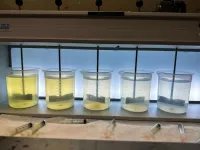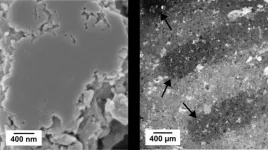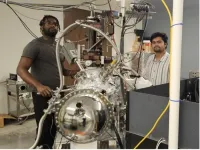(Press-News.org) In a groundbreaking effort to tackle the pervasive issue of PFAS contamination in drinking water, a research team at New Jersey Institute of Technology has received funding from the Bureau of Reclamation's Desalination and Water Purification Research program.
This highly competitive grant, awarded to only eight projects out of over eighty applicants, supports their innovative project titled "Enhanced Coagulation for the Removal of Per- and Polyfluoroalkyl Substances using Hydrophobic Ion Pairing Approach Project."
Arjun Venkatesan, associate professor in NJIT’s Civil and Environmental Engineering Department and the principal investigator of this work, is also leading a pilot study from the same program for the project “Enhancing the Removal of Hydrophilic Per- and Polyfluoroalkyl Substances by Granular Activated Carbon using Hydrophobic Ion-pairing as Pre-treatment” that utilizes a similar approach to tackle PFAS contamination.
Addressing the Challenges of PFAS Removal
Per- and polyfluoroalkyl substances (PFAS), often termed "forever chemicals," pose a significant challenge for conventional water treatment methods. The carbon-fluorine bonds in PFAS are among the strongest in chemistry, making these substances extremely resistant to natural degradation processes.
This persistence means PFAS remain in the environment indefinitely, accumulating over time and posing long-term health risks. Traditional treatment methods, such as granular activated carbon (GAC) filtration, struggle to effectively remove certain types of PFAS, particularly the hydrophilic (short-chain) variants.
"GAC is the go-to technology for PFAS treatment," said Venkatesan, who is also the director of NJIT’s Emerging Contaminants Research Laboratory (ECRL). "However, it doesn't work for all PFAS chemicals. Long-chain PFAS are removed efficiently, but short-chain PFAS, which are also toxic and regulated, are not."
The primary mechanism of PFAS removal by GAC relies on hydrophobic interactions, which are ineffective for the water-soluble short-chain PFAS. This gap in treatment capabilities necessitates innovative solutions to improve water safety and meet regulatory standards set by the US Environmental Protection Agency (EPA).
Innovative Solutions and Collaboration
The team's novel approach involves a pre-treatment process that significantly enhances the performance of existing GAC systems. By adding a chemical to the influent water that forms hydrophobic complexes with PFAS molecules, both short-chain and long-chain PFAS can be more effectively adsorbed onto the GAC surfaces. This process not only improves removal efficiency but also offers a cost-effective solution that can be readily implemented in existing water treatment facilities.
The Suffolk County Water Authority (SCWA) has played a crucial role in this project by providing access to a contaminated groundwater site for pilot testing. SCWA also offered in-kind support for the construction of the pilot filtration columns and additional water testing to complement the PFAS study, exemplifying the practical, community-focused nature of the research.
Promising Preliminary Results
While the pilot testing has just begun, laboratory tests have shown promising results. The pre-treatment approach has demonstrated a significant improvement in the time to breakthrough for PFAS removal. For instance, the time to 50% breakthrough for PFBS, a regulated short-chain PFAS, was improved by approximately 170%.
These preliminary findings suggest that the novel pre-treatment process could lead to substantial improvements in GAC performance, ultimately enhancing water quality and safety.
Real-World Impact and Future Research
With the new award, the team now is ready to demonstrate the novel pre-treatment approach for another commonly employed water treatment process called coagulation and flocculation. The simplicity and cost-effectiveness of this approach make it a viable option for widespread adoption.
"Our approach can be easily implemented in existing conventional water treatment systems with minimal modifications," said William Pennock, assistant professor in NJIT’s Civil and Environmental Engineering Department and collaborator on the coagulation and flocculation treatment research. "All we need is a chemical dosing pump to inject the HIP chemical into the untreated water."
This straightforward integration could result in significant operational cost savings for water treatment facilities, potentially reducing the frequency of GAC replacement by about 50%.
Looking ahead, the research team is also exploring the potential of the hydrophobic-ion pairing approach for other ionic organic contaminants, indicating a broad applicability of this technology. Future research will focus on testing biodegradable and environmentally friendly alternatives to the HIP chemical, ensuring the process does not introduce secondary contaminants.
This research aligns closely with the latest EPA regulations on PFAS in drinking water. By improving GAC filter performance and reducing operational costs, the proposed pre-treatment process addresses a critical national need. The successful implementation of this technology promises immediate and cost-effective enhancements to existing water treatment systems, benefiting communities and advancing public health protections.
This innovative research represents a significant step forward in the fight against PFAS contamination. By enhancing existing water treatment processes, the team is not only addressing a pressing environmental challenge but also providing practical, scalable solutions that can be adopted nationwide.
END
Novel pre-treatment process enhances PFAs removal from drinking water
The team's novel approach involves a pre-treatment process that significantly enhances the performance of existing GAC systems
2024-07-10
ELSE PRESS RELEASES FROM THIS DATE:
NASA’s Hubble finds strong evidence for intermediate-mass black hole in Omega Centauri
2024-07-10
Most known black holes are either extremely massive, like the supermassive black holes that lie at the cores of large galaxies, or relatively lightweight, with a mass of under 100 times that of the Sun. Intermediate-mass black holes (IMBHs) are scarce, however, and are considered rare "missing links" in black hole evolution.
Now, an international team of astronomers has used more than 500 images from NASA's Hubble Space Telescope — spanning two decades of observations — to search for evidence of an intermediate-mass black hole by following the motion of seven ...
The Society for Nutrition Education and Behavior (SNEB) issues its position on how to address emergency food and nutrition needs in disaster preparedness
2024-07-10
Philadelphia, July 10, 2024 – Despite escalating disaster frequency and severity, guidance for addressing emergency food and nutrition needs is limited. However, existing literature offers insights on how to effectively address emergency food and nutrition assistance. A recent position paper issued by the Society for Nutrition Education and Behavior (SNEB) in the Journal of Nutrition Education and Behavior, published by Elsevier, states that for effective recovery from and resilience to disasters, it is essential that impacted individuals and communities have access to safe, nutritious, and culturally and contextually appropriate foods and beverages, and receive emergency-related ...
Tackling the challenge of coca plant ID: wild vs cultivated for cocaine
2024-07-10
A new paper published today in Molecular Biology and Evolution reveals that it's not as straightforward as it might seem. Despite decades of data collection by the United Nations Office on Drugs and Crime (UNODC), which has been valuable to monitor changes in areas occupied by illegal coca plantations in South America, there is no reliable scientific method to distinguish between different types of coca plants.
South American coca plants have been essential to Andean and Amazonian communities for at least 8,000 years. It is within these communities that they are thought to have evolved from wild to domesticated coca plants. Their ...
BESSY II shows how solid-state batteries degrade
2024-07-10
Solid-state batteries have several advantages: they can store more energy and are safer than batteries with liquid electrolytes. However, they do not last as long and their capacity decreases with each charge cycle. But it doesn't have to stay that way: Researchers are already on the trail of the causes. In the journal ACS Energy Letters, a team from HZB and Justus-Liebig-Universität, Giessen, presents a new method for precisely monitoring electrochemical reactions during the operation of a solid-state battery using photoelectron spectroscopy at BESSY II. The results ...
Researchers show promising material for solar energy gets its curious boost from entropy
2024-07-10
Solar energy is critical for a clean-energy future. Traditionally, solar energy is harvested using silicon – the same semiconductor material used in everyday electronic devices. But silicon solar panels have drawbacks: for instance, they’re expensive and hard to mount on curved surfaces.
Researchers have developed alternative materials for solar-energy harvesting to solve such shortcomings. Among the most promising of these are called “organic” semiconductors, carbon-based semiconductors that are Earth-abundant, cheaper and environmentally friendly.
“They can potentially lower the production cost for solar panels because these ...
Faculty physicians to establish new community "health village" at Mondawmin Mall
2024-07-10
University of Maryland Faculty Physicians has entered into an agreement to lease 17,000 square feet of space at The Village at Mondawmin, which would establish a new community "health village," University of Maryland School of Medicine (UMSOM) Dean Mark T. Gladwin, MD, and Faculty Practice President William F. Regine, MD, announced today. It is part of a larger effort to work in partnership with the West Baltimore community to develop and implement health care delivery based on neighborhood needs and to improve patient access to healthcare.
The Faculty Practice group of ...
Pitch perfect: match the message to the idea's newness, study finds
2024-07-10
In a study examining styles of pitching ideas to audiences, researchers found that pitches promoting radical ideas are better received when framed in concrete and explanatory ‘how’ terms, while progressive ideas do better with abstract ‘why’ style of pitches.
Previous research found that professional audiences, like investors, prefer concrete pitches with how-style explanations, while lay audiences such as students and crowdfunders respond better to ‘why’ style pitches for abstract ideas.
Professor Simone Ferriani, Professor of Entrepreneurship at Bayes Business School (formerly ...
MSU study reveals rapid growth, persistent challenges in telemedicine adoption among US hospitals
2024-07-10
EAST LANSING, Mich. – A new study led by Michigan State University researchers shows a significant increase in telemedicine services offered by U.S. hospitals from 2017 to 2022, while also highlighting persistent barriers to its full implementation.
The comprehensive analysis of telemedicine adoption in U.S. hospitals during these years reveals both significant progress and ongoing challenges in the health care sector’s digital transformation. The study, published in the Journal of General Internal Medicine, found that the percentage of hospitals offering at least one form of telemedicine ...
Cirrhosis affects twice as many transgender adults as cisgender adults
2024-07-10
LOS ANGELES — Cirrhosis is chronic, progressive end-stage liver disease that occurs when scar tissue prevents the liver from functioning normally. Studies have shown that two of the leading causes of cirrhosis — alcohol use disorder and viral hepatitis — occur more frequently in transgender individuals, but there has been little research examining if these risk factors translate into greater incidences of cirrhosis among transgender patients.
A new study from Keck Medicine ...
Astronomers find the nearest massive black hole, a missing link in massive black hole formation
2024-07-10
Omega Centauri is a spectacular collection of about ten million stars, visible as a smudge in the night sky from Southern latitudes. Through a small telescope, it looks no different from other so-called globular clusters: a spherical collection of stars, so dense towards the centre that it becomes impossible to distinguish individual stars. But now a new study, led by Maximilian Häberle (Max Planck Institute for Astronomy), confirms what astronomers had been suspecting for some time: Omega Centauri contains a central black hole. The black hole appears to be the “missing link” between its stellar and ...
LAST 30 PRESS RELEASES:
Decoupling the HOR enhancement on PtRu: Dynamically matching interfacial water to reaction coordinates
Sulfur isn’t poisonous when it synergistically acts with phosphine in olefins hydroformylation
URI researchers uncover molecular mechanisms behind speciation in corals
Chitin based carbon aerogel offers a cleaner way to store thermal energy
Tracing hidden sources of nitrate pollution in rapidly changing rural urban landscapes
Viruses on plastic pollution may quietly accelerate the spread of antibiotic resistance
Three UH Rainbow Babies & Children’s faculty elected to prestigious American Pediatric Society
Tunnel resilience models unveiled to aid post-earthquake recovery
Satellite communication systems: the future of 5G/6G connectivity
Space computing power networks: a new frontier for satellite technologies
Experiments advance potential of protein that makes hydrogen sulfide as a therapeutic target for Alzheimer’s disease
Examining private equity’s role in fertility care
Current Molecular Pharmacology achieves a landmark: real-time CiteScore advances to 7.2
Skeletal muscle epigenetic clocks developed using postmortem tissue from an Asian population
Estimating unemployment rates with social media data
Climate policies can backfire by eroding “green” values, study finds
Too much screen time too soon? A*STAR study links infant screen exposure to brain changes and teen anxiety
Global psychiatry mourns Professor Dan Stein, visionary who transformed mental health science across Africa and beyond
KIST develops eco-friendly palladium recovery technology to safeguard resource security
Statins significantly reduce mortality risk for adults with diabetes, regardless of cardiovascular risk
Brain immune cells may drive more damage in females than males with Alzheimer’s
Evidence-based recommendations empower clinicians to manage epilepsy in pregnancy
Fungus turns bark beetles’ defenses against them
There are new antivirals being tested for herpesviruses. Scientists now know how they work
CDI scientist, colleagues author review of global burden of fungus Candida auris
How does stroke influence speech comprehension?
B cells transiently unlock their plasticity, risking lymphoma development
Advanced AI dodel predicts spoken language outcomes in deaf children after cochlear implants
Multimodal imaging-based cerebral blood flow prediction model development in simulated microgravity
Accelerated streaming subgraph matching framework is faster, more robust, and scalable
[Press-News.org] Novel pre-treatment process enhances PFAs removal from drinking waterThe team's novel approach involves a pre-treatment process that significantly enhances the performance of existing GAC systems








